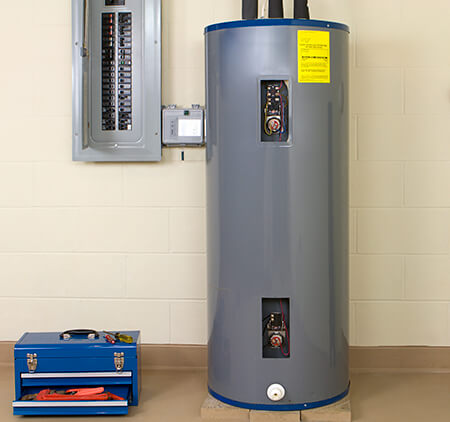
Your water heater is one of your home’s most important appliances. Like all other major appliances, water heaters require regular maintenance to keep functioning properly. One important maintenance task that many people ignore is flushing their water heater tank. If the unit isn’t periodically flushed, it can cause sediment to build up in the bottom of the tank, which can impact how efficiently the unit heats and how much hot water you have. Ideally, you should flush the tank every one to three years, and here is a full overview of how to do it.
Turn Off the Unit and the Cold Water Supply
The very first thing you’ll want to do is turn off the unit. If you have an electric water heater, you should turn off the power to the unit by flipping the circuit breaker that controls it. For gas units, first turn the knob so that the pilot light shuts off and then close the valve that supplies gas to the unit.
If you have a newer unit with an automatic pilot, you should flip the circuit breaker controlling the pilot and shut off the gas coming into the unit. Once you are sure the unit is off, you’ll then want to shut off the unit’s cold-water supply.
Open Your Hot Water Taps
Once the unit is off and no more cold water is flowing to it, you should then turn all your faucets on to the hot setting. Continue to let them run until the water turns cold. This step is extremely important. You want to make sure the water inside the tank is no longer hot to prevent potential burns from scalding water. If you’re worried about wasting water, there’s another option. Turn off the tank and let it sit for a few hours until the water that comes out of your hot water tap is cool enough to touch comfortably.
Once the water is cold, you can then shut off all but one or two of the faucets. You should always leave at least one faucet running while draining and flushing the tank as this helps to prevent a vacuum from forming, which could prevent the tank from draining properly.
Drain the Tank
The next step is to connect a garden hose to the drain outlet near the bottom of the tank. If your water heater is in the basement, it will most likely have a floor drain nearby where you can put the other end of the hose so that the water drains out of the house. Alternatively, you can drain the water into a bucket and dump it outside or down a drain. If you are using a drain, it helps to use a mesh colander to catch the sediment so that it doesn’t clog the drain.
Once the hose is connected, make sure that you have a hot water tap open, then slowly open the valve and let the tank drain. The water will usually be quite dirty looking or rust-colored to start, and you should also see quite a bit of sediment coming out. Depending on how much sediment there is in the tank and how large the tank is, it could take quite some time for it to drain.
If it stops draining, it could be that there is a vacuum in the tank or that the drain valve is clogged with sediment. You can check this by lifting up the pressure release valve. This should get rid of the vacuum and allow the water to start flowing again. If this doesn’t work, the drain valve is likely clogged.
You may be able to unclog the valve by removing the hose and gently poking a wire or rod up into the valve. Before attempting this, make sure to put a bucket or pot under the valve to catch any water that starts to drain. If the unit still won’t drain, you will most likely need to hire a professional to replace the valve.
It is important to note that you usually won’t have to fully drain the tank before you start to flush it. The sediment only sits at the bottom of the tank. When you turn the cold-water supply back on to the tank, the dip tube directs the water coming into the unit to the bottom, so you can effectively flush it without needing to drain the entire tank.
It is also important to read your owner’s manual before draining your tank, as some units always need to stay full or else they can become damaged. In this case, you can skip this step and move straight on to flushing the unit.
Flush the Unit
After draining some of the water and sediment out of the tank, you can turn the cold-water supply back on. This will allow water to flow through the unit to flush out any remaining sediment. Continue to flush the unit until the water coming out of the hose is completely clear, with no remaining traces of sediment. This will usually take only a few minutes, but it could take longer if your tank has a lot of sediment or has never been flushed.
Refill the Tank, and Turn the Unit Back On
Once you’re satisfied that the tank is fully flushed, close the drain valve, disconnect the hose, then turn the unit back on. For electric water heaters, all you need to do is flip the circuit breaker back on. If you have a gas unit, you will need to turn the gas back on and then relight the pilot light. Once the unit is back on, go to the hot water tap that you left running, and wait until cold water starts to flow out of the faucet. You can then turn off the faucet and wait for the water to reheat.
Benefits of Flushing Your Water Heater Tank
Sediment buildup is the primary reason why most traditional water heaters fail. When sediment sits on the bottom of the tank, it can create hot spots that reduce the unit’s efficiency or damage the tank. On electric water heaters, the sediment can also damage or even ruin the lower heating element. By regularly flushing your tank, you can improve the unit’s efficiency, reduce your energy costs, and extend the lifespan of the unit.
Flushing your tank can also eliminate any issues with popping, knocking, or other loud noises coming from the water heater. These noises are caused by steam rising up through the sediment, and the issue should immediately go away as soon as you have flushed the tank and gotten rid of all the sediment.
Expert Plumbing and Home Services
If you are having any issues with your water heater, the professional plumbers at Liberty Comfort Systems are here to help. We offer repair and maintenance services for both traditional and tankless water heaters, and we work on equipment from any manufacturer. Our team also specializes in water heater replacement and installation, and we carry a range of units both large and small. We also specialize in heating and air conditioning services for customers in Anoka, MN and the surrounding areas. No matter what type of plumbing or HVAC service you need, give us a call today, and let our experts get to work for you.

